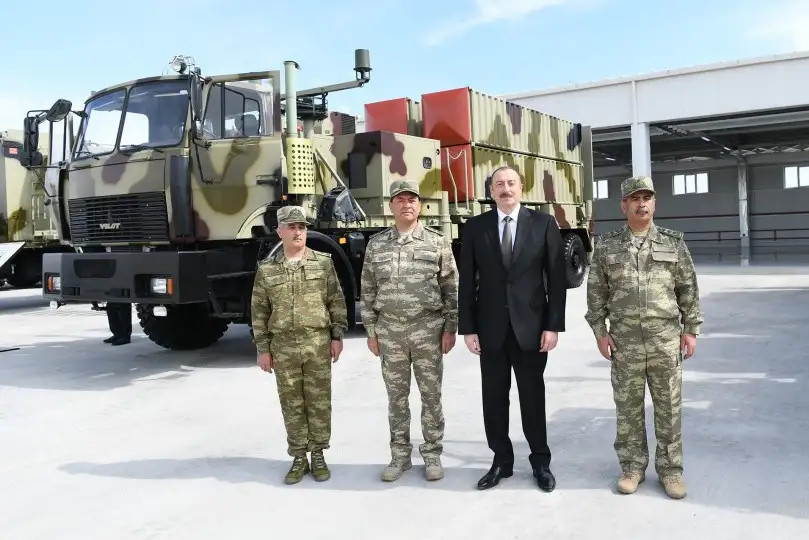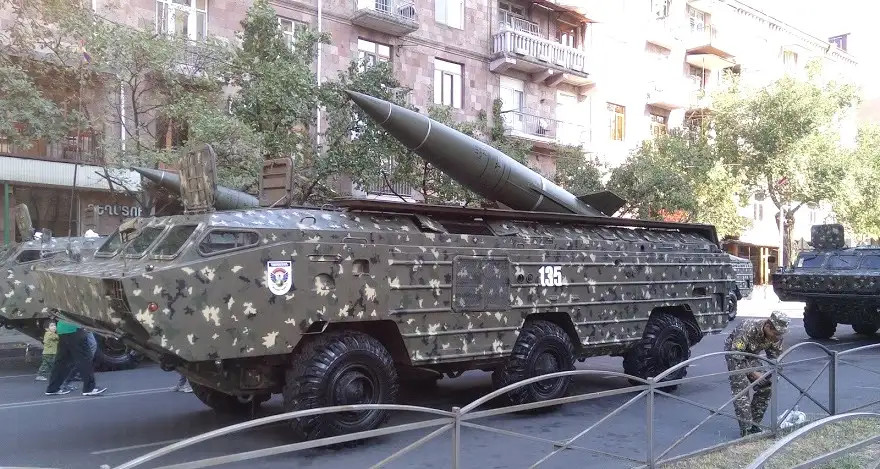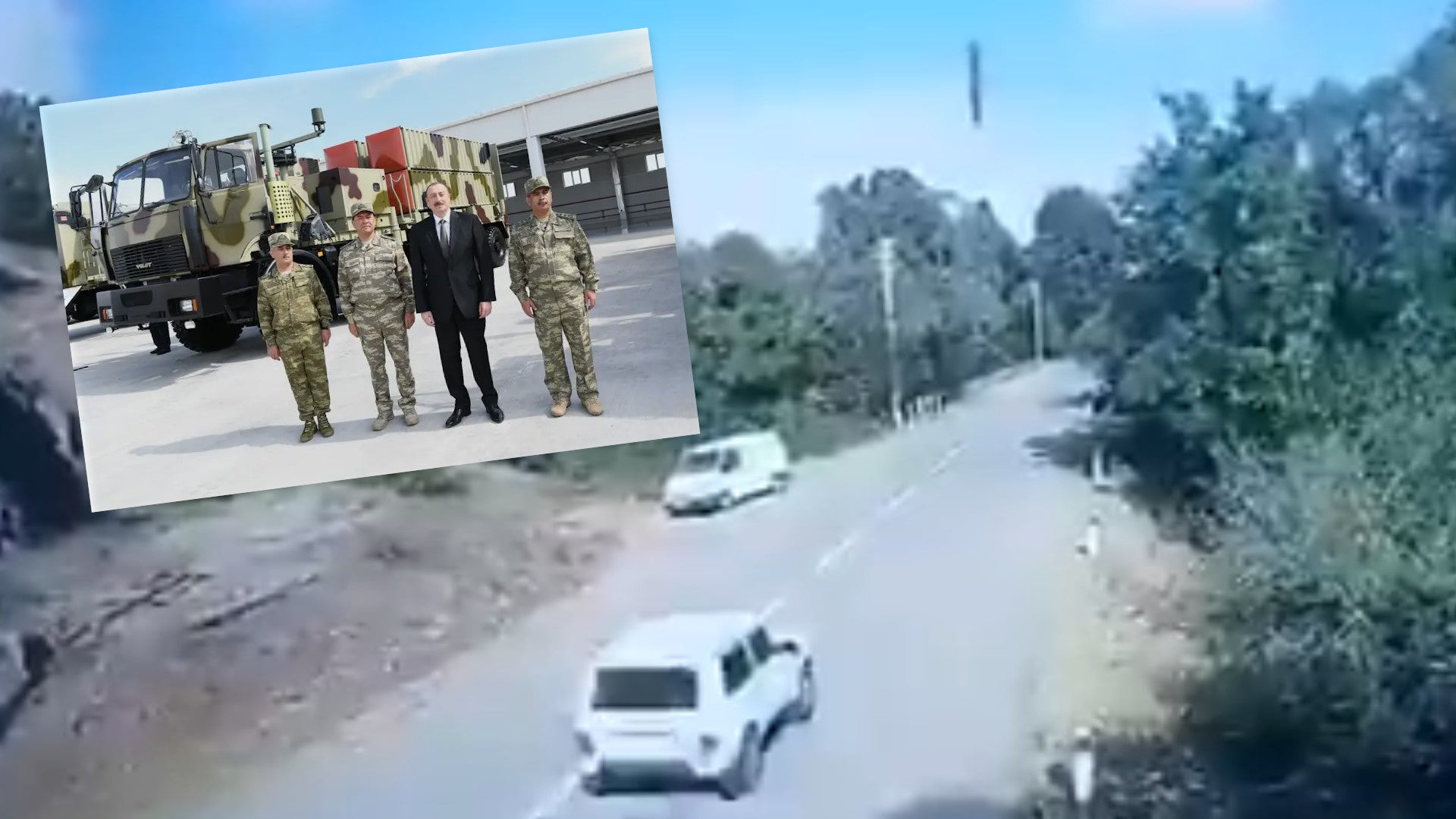Video has emerged online suggesting that Azerbaijan has employed one of its Israeli-made LORA short-range ballistic missiles to cut a bridge between Armenia and the disputed territory of Nagorno-Karabakh. If confirmed, this would be the first use of this weapon in combat anywhere in the world and represent a significant escalation in the nearly week-old conflict between the two countries over this long-disputed region.
The clip of the missile reportedly hitting the bridge near the Armenian border village of Asagi Sus first appeared on social media on Oct. 2, 2020. This development comes amid a new and particularly serious burst of fighting between Armenia and Azerbaijan over Nagorno-Karabakh, which first erupted on Sept. 27. You can learn all about this emerging conflict in the War Zone‘s previous coverage of the crisis. Since a ceasefire deal ended a war over the region in 1994, the territory, which is widely recognized to be part of Azerbaijan, has been under the de facto control of the Armenian-backed Republic of Artsakh. There have been numerous skirmishes and bouts of more significant fighting in the intervening decades.
In the new footage from Asagi Sus, which appears to have been captured via a close circuit television (CCTV) system of some kind, the missile is visible briefly before it impacts. It looks to be similar, if not identical in shape and size to Israel Aerospace Industries’ LORA, which stands for Long Range Attack. Azerbaijan received as many as 50 LORA missiles, along with trucks equipped with four-round containerized launchers, between 2017 and 2018, according to the Stockholm Internal Peace Research Institute’s databases.
Rob Lee, a PhD student in the Department of War Studies at King’s College London who researches Russian defense policy and related issues, Tweeted out that using LORA for this kind of precision strike would have made good sense given its reported ability to reliably hit within 10 meters, or just under 33 feet, of the designated target. Azerbaijan’s Soviet-era Tochka-U short-range ballistic missiles are not nearly as precise, nor are its very long-range rocket artillery systems.
LORA’s ability to carry a 1,000-pound-class unitary high-explosive warhead would also make it powerful enough to severely damage or destroy a target such as a bridge. The other precision-guided weapons Azerbaijan has employed so far in the conflict are small glide bombs dropped from its Turkish-made Bayraktar TB2 armed drones and various Israeli-made loitering munitions, none of which have this kind of destructive capability.
Beyond taking out bridges, LORA could offer Azerbaijan a means to block tunnels or simply crater narrow roads in the mountainous Nagorno-Karabakh region, which is already hard to traverse in many places for vehicles, especially heavy armor. As such, these missiles could have a very valuable strategic role in preventing the movement of reinforcements and other supplies to the front lines.

At the same time, the use of these ballistic missiles would also represent a notable escalation in the conflict that could draw an in-kind response from Armenia. Azerbaijani authorities have already accused Armenian forces of employing their own Tochka-Us in the conflict. Armenia’s Ministry of Defense denied those accusations and warned Azerbaijan against provoking a real missile strike. Armenia’s armed forces notably have more modern Russian-made Iskander-E quasi-ballistic missiles, in addition to their Soviet-era Tochka-U and Scud short-range-range ballistic missiles.

There were reports that some of Armenia’s Russian-made S-300 surface-to-air missile systems had shot down incoming missiles headed toward the country’s capital Yerevan on the night of Oct. 1-2, leading to speculation that Azerbaijan might have fired ballistic missiles at the city. The Armenian Ministry of Defense subsequently claimed that the S-300s had downed three unspecified Azerbaijani drones, not missiles.
No matter how the use of ballistic missiles in the current Nagorno-Karabakh conflict does or does not evolve, there already is and continues to be a very real air war, which Azerbaijan’s TB2 drones and loitering munitions have so far dominated. These unmanned aircraft have scored dozens of hits so far on a wide array of assets belong to Armenian forces and those the Republic of Artsakh, including air defense systems, tanks and other armored vehicles, and more.

The ominous hum of the small engine on the Israeli-made Harop loitering munition, which you can read about more in this past War Zone piece, has become a persistent feature of the fighting. Azerbaijani authorities have certainly sought to capitalize on the potentially demoralizing impact of these explosive-laden drones constantly zipping around the battlefield. The country’s Border Guard so far has released at least two very brief propaganda videos simply featuring the Harop and the sound of its engine along with the message “Karabakh is Azerbaijan!.”


The Border Guard has also released a music video in which the Harop is featured prominently, along with other weapons, including the country’s Russian-made TOS-1A thermobaric artillery rocket launchers. The over-the-top patriotic video features singers Narmin Karimbayova, a former The Voice of Azerbaijan contestant, and Ceyhun Zeynalov, as well as the band Nur Group. Two years ago, Karimbayova and Nur Group also performed in a similar production two years ago, which also offered a then-rare look at Azerbaijan’s Harops.

Armenian and Republic of Artsakh forces claim to have shot down dozens of Azerbaijani drones, but it has been extremely difficult to independently verify these claims. Videos are circulating on social media reportedly showing Azerbaijani An-2 biplane aircraft being shot down over the region, as well. It’s not clear how these aircraft being used in the conflict, but they could be used to insert specialized personnel or conduct small aerial supply drops in hard to reach areas. These aircraft, which you can read about more in this past War Zone piece, can fly very low and slow and have a relatively small radar signature given their fabric-covered wings.
On the Armenian side, there continue to be so far unsubstantiated claims that a Turkish F-16 fighter jet shot down one of that country’s Su-25 Frogfoot ground-attack aircraft. There are also competing reports that two Armenian Su-25s have been lost, so far, after hitting mountainsides during low-level operations in the region.
How the conflict, overall, may continue to develop, no matter what weapons are being used, remains to be seen. Russia, one of Armenia’s chief international partners, has issued a joint call for a ceasefire together with France and the United States. The three countries are members of what is known as the Minsk Group, which the Organization for Security Cooperation in Europe (OSCE) formed in the early 1990s to help bring an end to the fighting over Nagorno-Karabakh that was raging at that time.
Armenia has welcomed that call, but has demanded that Turkey first end its support for Azerbaijan. Turkey denies being actively involved in the fighting, but there are mounting reports that the Turkish government has facilitated the movement of Syrian militants into the country to bolster Azerbaijani forces. Azerbaijan has called for the full restoration of its control over the region as a prerequisite for a ceasefire and Turkey has said it fully supports that position.
What is clear is that the fighting shows no signs of slowing down yet and may be entering a new, more serious phase if ballistic missiles, such as Azerbaijan’s LORAs, begin seeing more widespread use in the conflict.
Contact the author: joe@thedrive.com
